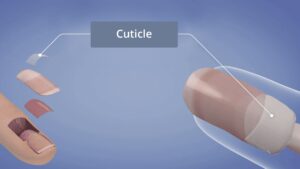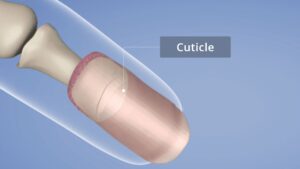Tìm kiếm câu trả lời bạn đang tìm kiếm.

Cuticle
12,6 nghìn lượt xem
The cuticle is created by the eponychium on the ventral (on underside) surface of the proximal nail fold. The cuticle is formed of sticky dead skin cells that are shed by the living skin of the PNF just like the skin cells are from any surface of epidermis but instead of falling off in flakes, they are bound together with a very sticky substance, that sticks them firmly to the emerging nail plate beneath them and the frame of keratinised epidermis above them. This important part of the nail seal (or guardian) at the base of the nail is curated by the eponychium which ‘sticks’ the dead skin cells together.
Lớp da chết mỏng này bám chặt vào móng tay và nếp gấp móng tay gần, forming an important seal that protects the important matrix that is behind and below the PNF. This is non-living skin, though, and is safely removed prior to manicures and pedicures, to avoid any lifting of artificial nails, for example.
Hỏi các chuyên gia
Bạn có nên đẩy lớp biểu bì ra không?
The answer to this is NO! The cuticle that is exposed and on the nail plate can be safely removed as it is non-living tissue, however to prevent infection of the finger, stop when you reach the frame of keratinised epidermis at the edge of the proximal nail fold. If you go further, and push deep under the proximal nail fold, you open the area up to infection.
Trên thực tế, lớp biểu bì cần được nhấc ra khỏi móng khi nó mềm ra và sau đó được loại bỏ.
Vai trò của lớp biểu bì là gì?
With the proximal nail fold and the nail plate sealed together with the sticky cuticle in the middle, there is a very efficient first line of defense against all types of invaders from pathogens to chemicals to fungus spores. Any of these that reach the delicate matrix can very easily interrupt the growth of the nail plate and even stop growth altogether.
Lớp biểu bì được tạo thành từ gì?
Lớp biểu bì là tế bào da không màu, không sống.
Làm thế nào để loại bỏ lớp biểu bì?
Lý tưởng nhất là trước khi bạn làm bất cứ điều gì với lớp biểu bì trên móng tay, nó cần được làm mềm. Theo truyền thống, điều này đã đạt được bằng cách ngâm móng tay trong nước mềm. Điều này SẼ làm mềm lớp biểu bì rất hiệu quả NHƯNG nó cũng sẽ tạo ra tác dụng không mong muốn cho móng tay.
The nail plate is hydrophilic, meaning it loves water and is very porous due to the time air spaces within it. If it is soaked in water for 1 minute or more, it will allow water to penetrate the structure, change the shape, temporarily, and make it very soft until the excess water has evaporated. Then it will return to its original shape and regain its hardness.
If an overlay of any kind is applied to a ‘water logged’ nail plate there is a good chance of lifting when the nail returns to its original shape.
Các sản phẩm và kỹ thuật hiện đại đã không còn ngâm nước nữa mà sử dụng các sản phẩm làm mềm biểu bì hiệu quả hơn nhiều.
These can be an alkaline based product such as sodium hydroxide. This is very efficient at breaking the bonds between dead skin cells and softening the layer. It should, however, NOT be left on the nail nor skin as it will continue to work and will also soften the nail plate and make it very susceptible to damage during the nail service. It needs to be neutralised by a mild solution of soapy water that can be applied via a water spray and drying with a disposable wipe or by washing the hands with liquid soap and running water.
Ngoài ra, áp dụng một cách tốt dầu móng tay khi bắt đầu dịch vụ nhưng sau khi móng đã được loại bỏ lớp phủ và được làm sạch. Điều này có thể làm mềm hiệu quả lớp da chết của lớp biểu bì trong khi móng đang được định hình. Sau đó, lớp da mềm có thể được loại bỏ an toàn bằng một dụng cụ cắt lớp biểu bì tốt trong khi thực hiện cate để không làm hỏng bề mặt móng cũng như PNF.
This process can also be safely achieved using an e-file. This technique needs education, a slow e-file speed, suitable e-file bit and, preferably oil to minimise any nail plate damage.
There are some e-file techniques that are very extreme in the removal of skin in this area. If you understand the structure and purpose of the PNF it is very clear that this area must be protected at all costs. The ‘seal’ must NOT be broken and therefor opening the matrix to pathogens.
Those nail pros and, indeed, respected educators, who carry out and teach the extreme version of this technique, clearly have no real understanding of the physiology and pathology of the area! (Maybe link to all or any of Vitaly or Doug’s articles on this topic)
Kết luận:
- Lớp biểu bì là lớp da chết mỏng trên bề mặt móng tay.
- Nó được tạo thành bởi lớp màng móng ở mặt dưới của nếp gấp móng tay gần.
- The cuticle is the middle layer of the proximal nail fold and nail plate, and it forms a crucial seal at the base of the nail, safeguarding the delicate matrix.
- Có thể tháo bỏ một cách an toàn và hiệu quả mà không làm hỏng lớp niêm phong.
- Việc loại bỏ lớp biểu bì là cần thiết để tạo điều kiện cho lớp phủ bám dính vào móng và để có được mép lớp phủ sạch sẽ và gọn gàng.
Thư viện hình ảnh


